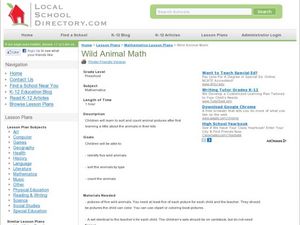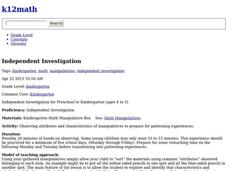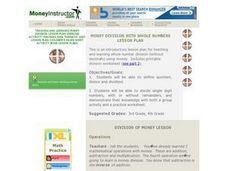Bright Hub Education
Math Lesson for Visually Impaired Early Learners: A 3 Way Counting Activity
A unique lesson that's designed for visually impaired early learners, but can be adapted for anyone, is here for you. Pupils use brightly colored foam letters, beads, checkers, and an abacus, in order to gain practice in identifying the...
Curated OER
Preschool Lesson: Guinea Pigs
In this Guinea Pig themed lesson, students hear the story, Guinea Pigs Add UP! and then engage in several themed learning activities. Each activity fosters skills in letter/number recognition, art, math or writing.
Curated OER
Kitchen Math For Preschoolers
Students turn kitchen time into learning time. Parents can use opportunities abound at home using "real" objects to teach beginning math. When learning begins with real objects and experiences, children use all of their senses-thus...
Curated OER
Long Train: 101 Cars on the Track Lesson Plan
Students practice counting, measuring, and predicting. In this early childhood lesson plan, students identify numbers 1-101, rhyming words, and repetitive words using Long Train by Sam Williams. Students build their recall skills by...
EngageNY
Using Tree Diagrams to Represent a Sample Space and to Calculate Probabilities
Cultivate the tree of knowledge using diagrams with two stages. Pupils create small tree diagrams to determine the sample space in compound probability problems. The lesson uses only two decision points to introduce tree diagrams.
Practical Money Skills
Making Decisions
A set of quizzes and assessments would make a great companion to your instructional activity on making decisions and opportunity risks. Learners watch a PowerPoint before answering multiple choice questions about interest rates, saving...
Curated OER
Zoo Phonics Preschool Lesson
Have your class discuss the letter /l/ sound. Using a variety of entertaining books, preschoolers identify the sound of this letter. This is a terrific way to review the letter L.
Curated OER
Wild Animal Math
Students examine wild animals. In this sorting and counting lesson, students are introduced to animals by viewing pictures. Students discuss the sounds they make, where they live and what they eat. Students pretend to be the animals....
Math Solutions
Shape Sorting: Looking for Green!
Young mathematicians rotate, flip, and sort their way to an understanding of the different attributes of geometric figures. Using transparent yellow and blue shapes, children try to match congruent figures together...
Curated OER
Technonumbers: Computers in Preschools
Students explore recognizing, counting and sequencing numbers 1-10. In this primary math introduction instructional activity, students participate in 6 computer sessions that integrate short films, music and drawing in order to bring...
Curated OER
Math & Science
Young scholars are introduced to techniques to help with with math and science. In groups, they use a worksheet to discover how to count money. As a class, they watch a PowerPoint to define terms associated with science. To end the...
Visa
Making Spending Decisions
By role playing real-world experiences, such as purchasing snacks and grocery/toy store shopping, your youngsters will begin to develop an understanding of how to make decisions and choose between alternatives. This is the first...
Curated OER
Shadows
Young scholars read books, learn about the letter s, and eat raisins all to learn about shadows. For this shadows lesson plan, students also go outside and look at shadows and sing songs about shadows.
Curated OER
Learning The Basic Shapes
Pupils explore basic shapes concepts. For this math lesson, students examine circles, triangles, squares, and rectangles as they draw the figures they see on worksheets.
Curated OER
Stuffed Animals Measuring
Students measure stuffed animals with various materials such as dog biscuits, paper clips, and yarn. In this measurement instructional activity, students measure the stuffed animals, and understand the concept of long and short and big...
Curated OER
Sequencing
Students explore the math concept of sequencing. In this math lesson, students examine patterns and determine the patterns needed to finish sequences.
Curated OER
Independent Investigation
Students classify objects. In this math lesson, students sort and classify objects based on their characteristics. Students identify characteristics of objects.
Curated OER
Literacy Activity: Mouse Shapes
Students listen to the book Mouse Shapes and identify the shapes in the book as it is being read. In this shapes instructional activity, students identify the shapes in the book, and then play with cut out shapes that they can hold in...
Curated OER
Squares
Students identify shapes that are squares. In this square lesson, students identify the square items and then sing songs about squares.
Curated OER
Shapes Sally Snake Can Make Story Book
Students listen to the book Shapes Sally Snake Can Make while they hold their own snake made out of a pipe cleaner. In this shapes lesson plan, students develop their listening skills while the book is read to them, and then they...
Curated OER
Counting Lesson Plan
Students practice counting, reading, and writing the numbers 0 through 5. For this basic counting lesson, students review a counting book, use macaroni as a manipulative, and learn a song as a means to learn and practice writing and...
Curated OER
Kindergarten Math Counting
Students practice their counting skills. In this counting practice lesson, students count from one to five orally, write the numbers through five independently, identify the numbers, and use macaroni for a hands on counting activity.
Curated OER
Money Division With Whole Numbers Lesson Plan
Learners define quotient, divisor and dividend. They divide single digit numbers, with or without remainders, and demonstrate their knowledge with both a group activity and a practice worksheet.
Curated OER
Veggie Chop and Data Analysis
First graders chop vegetables into fractions. In this fractions lesson plan, 1st graders cut vegetables, collect data about favorite vegetables and create a bar graph using the information. Students make inferences about the data...























